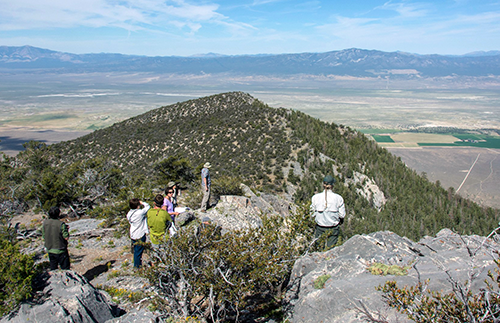
Previous Meetings CIRMOUNT AGU 2015 Session
Why Mountains?
 Mountain areas of the world are attracting increased attention as observations and climate model simulations indicate that these
regions will be greatly impacted by global climate change and are early warning indicators of future impacts worldwide. Mountain
ecosystems of the western United States are complex, and include cold desert biomes, alpine biomes, and tundra ecosystems occurring
above timberline. The alpine ecosystem within the cordilleran region that extends into Central America is the only one that exists
in all different climatic zones from the equator to the polar region. This environment is among the most sensitive to climatic changes
occurring on a global scale, comprising glaciers, snow, permafrost, water, and the uppermost limits of vegetation and other complex
life forms. The stratified, elevationally-controlled vegetation belts found on mountain slopes represent an analogue to the different
latitudinally-controlled climatic zones, but these condensed vertical gradients are known to support unique hotspots of biodiversity.
High relief and high gradients make mountain ecosystems especially vulnerable to slight changes of temperatures and to extreme
precipitation events. In effect, mountains have become the proverbial “canary in the coal mine” in terms of their
sensitivity to climate and other environmental changes, yet their critical importance and vulnerability are often overlooked.
Mountain areas of the world are attracting increased attention as observations and climate model simulations indicate that these
regions will be greatly impacted by global climate change and are early warning indicators of future impacts worldwide. Mountain
ecosystems of the western United States are complex, and include cold desert biomes, alpine biomes, and tundra ecosystems occurring
above timberline. The alpine ecosystem within the cordilleran region that extends into Central America is the only one that exists
in all different climatic zones from the equator to the polar region. This environment is among the most sensitive to climatic changes
occurring on a global scale, comprising glaciers, snow, permafrost, water, and the uppermost limits of vegetation and other complex
life forms. The stratified, elevationally-controlled vegetation belts found on mountain slopes represent an analogue to the different
latitudinally-controlled climatic zones, but these condensed vertical gradients are known to support unique hotspots of biodiversity.
High relief and high gradients make mountain ecosystems especially vulnerable to slight changes of temperatures and to extreme
precipitation events. In effect, mountains have become the proverbial “canary in the coal mine” in terms of their
sensitivity to climate and other environmental changes, yet their critical importance and vulnerability are often overlooked.
When mountains change society feels the impact. Mountains are complex social-ecological systems that influence people's lives through the ecosystem services they provide (e.g., fresh water, hydroelectricity, habitat). Relatively small perturbations in global processes can cascade to large changes in the mountainous regions of western North America, which in turn affect the socioeconomic well being of this region and the nation at large. A number of academic, agency, and NGO efforts are underway to develop regional-scale integrated climate research efforts and enable the monitoring activities to support them. Such efforts are justified by the importance of mountain environments and ecosystem services to society, the sensitivity of mountain ecosystems to climate change, and the rapid response of these regions to small changes in atmospheric conditions.
The MtnClim meetings
 In 2004 an inaugural conference on mountain
climate was held at Lake Tahoe. The meeting was attended by a broad cross-section of scientists, agency representatives, and university researchers
from across the US and abroad. The quality and diversity of the science discussed at that meeting convinced participants that a biannual meeting
should be established that is dedicated to mountain climate sciences and effects of climate variability on ecosystems, natural resources, and
conservation in western North American mountains.
In 2004 an inaugural conference on mountain
climate was held at Lake Tahoe. The meeting was attended by a broad cross-section of scientists, agency representatives, and university researchers
from across the US and abroad. The quality and diversity of the science discussed at that meeting convinced participants that a biannual meeting
should be established that is dedicated to mountain climate sciences and effects of climate variability on ecosystems, natural resources, and
conservation in western North American mountains.
Every even-numbered year since that initial meeting has seen a MtnClim conference featuring invited and contributed talks, poster sessions, and working-group sessions on various aspects of mountain climate science including hydrology, ecology, and glaciology. Every MtnClim meeting also includes post-conference workshops for natural-resource managers to address the management implications of climate variability and climate change in conservation and resource management. To encourage discussion and interaction, we have capped attendance at 120 participants, and conferees represent an array of agency and academic backgrounds and disciplinary fields. More information on previous conferences is available here: http://www.cirmount.org/meetings/mtnclim.shtml.
Key features of the MtnClim Conferences include:
- Invited oral sessions:
- Three keynote speakers (research and policy themes) on cutting-edge science themes and decision making
- Early-career scientists’ session
- Two panel discussions
- Invited speakers on local issues of relevance
- Contributed oral and poster sessions
- Working group discussions
- Discussion forums on action proposals, including interactions with local agencies
- Field trips to research and/or management demonstration sites
- Post-conference Resource-Managers’ Forums: a focused discussion between scientists and resource managers on emerging issues and adaptive management options.